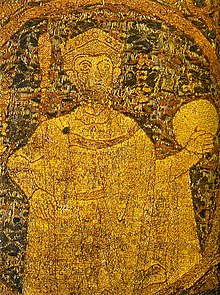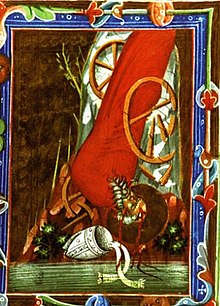Gerard of Csanád
Roman Catholic Church Eastern Orthodox Church | |
|---|---|
| Canonized | 1083 by Pope Gregory VII |
| Feast | 24 September |
| Patronage | Hungary, Budapest |
Gerard or Gerard Sagredo (
He left Venice for a pilgrimage to the
Sources
Most information of Gerard was not preserved in impartial sources, but in his hagiographies.[1] The Short Life of Saint Gerard, which was composed around 1100, is an abridgement of an earlier biography.[2][3] The earlier biography did not survive.[4] The Short Life primarily presents Gerard as a bishop.[1] The majority of scholars regard the Short Life the most reliable source of Gerard's life.[3]
The Long Life of Saint Gerard is a compilation of multiple sources, including the biography that the author of the shorter legend had also utilized.[5][6] The Long Life was completed in the late 13th century or in the 14th century.[5][6] It was regarded as a source of absolute reliability for centuries, but this view radically changed in the 20th century.[3] György Györffy even stated that the Long Life was a forgery.[3] Historian Gábor Klaniczay also emphasizes that the longer legend contains obviously anachronistic elements.[7] On the other hand, Carlile Aylmer Macartney says that the Long Life preserved the original form of Gerard's earliest (now lost) biography.[8]
Gerard's own work, the
Family and youth
Gerard's Long Life dedicates two chapters to his family and childhood.[10][5] Conventional elements of medieval hagiographies abound in both chapters, suggesting that the author borrowed many motives from other legends, especially from the Life of Saint Adalbert of Prague.[5] Gerard was born in Venice in a noble family.[10] The noble origin of saintly hermits was often emphasized in their legends.[10]
The identification of Gerard's family is uncertain.[10] An expanded version of Petrus de Natalibus's Catalogue of Saints, which was published in 1516, identified Gerard as a member of the Sagredo family.[11] Although the family was granted Venetian nobility only in the 14th century, some scholars (including Fabio Banfi) accept the Sagredos' claim to their kinship with Saint Gerard.[11] Historian László Szegfű says that Gerard was actually a Morosini.[12]
Gerard's father, who was also named Gerard, and mother, Catherine, had awaited his birth for three years.[10] They baptised their son George because he was born on the feast of Saint George (23 April).[10][13] The year of his birth is unknown, but he was born between around 977 and 1000.[10][13][12] He was renamed in the memory of his father who died during a pilgrimage or journey (anachronistically mentioned in Gerard's Long Life as a crusade).[14]
Ecclesiastic career
Benedictine monk
At the age of five, Gerard was taken seriously ill.[15] His recovery was attributed to the prayers of the Benedictine monks of the San Giorgio Monastery in Venice.[13] His family soon sent him to the monastery, offering him to spiritual life.[4][15] Gerard took the "religious cloth" and was educated in the monastery.[11] He could read and write and knew the basic elements of arithmetic.[16] His Long Life emphasizes that Gerard strictly observed the rules of monastic life and wore coarse cloths to "mortify his body".[17] He also studied the "words of the prophets and the speeches of the Orthodox apostles".[17] The use of certain expressions (including dux verbi, or "leader of the Word") suggests that Gerard read Pseudo-Dionysius the Areopagite in Greek.[18]
After the founding abbot of the monastery, John Morosini, died in 1012, Gerard was appointed prior to administer the monastery until the new abbot, Guglielmo, was elected.[17] Guglielmo sent Gerard to "Bologna" to study grammar, music, philosophy and law.[19] Gerard mentioned his stay in Gaul, where he read Plato, suggesting that the original version of the Long Life or its source referred to his studies in Burgundy instead of Bologna.[12][20] Gerard returned to the San Giorgio Monastery five years later.[17] His Long Life writes that Gerard was made abbot although he had been opposed to his election.[17] No information about his activities as abbot was preserved in the sources, implying that he actually never held that office.[13][4][17]
Gerard left for a pilgrimage to the
Royal tutor and hermit

Gerard and Rasina visited
Maurus and Anastasius convinced Gerard, who wanted to continue his pilgrimage to the Holy Land, to meet King Stephen I in
Gerard was made the tutor of Stephen's son and heir, Emeric.[31] Gerard's role as the crown prince's tutor was only mentioned in the Long Life, implying that this was only an invention by the hagiographer who wanted to create a strong connection between the three most important saints of the early Kingdom of Hungary, but the story is not surely invented.[31][5] Szegfű writes that Gerard may have influenced Stephen's Admonitions to Emeric.[12] László Mezey proposes that Gerard was only responsible for the spiritual education of Emeric.[32]
After Emeric's education was completed, Gerard settled in the
Bishop of Csanád
A powerful chieftain,
After the conquest of Ajtony's territory, Stephen I summoned Gerard from his hermitage and made him bishop of the newly established
Gerard and the Benedictine monks shared a house and he forbade them to leave it without his authorization.[46] The monks were required to be present for the morning service and to wear monastic costume.[47] Gerard continued to wear the habits of a hermit (cilice or goat skins) and spent days in solitude in the forests near his see.[48] His legend also writes that he often "took the axe" to cut woods to "mortify his flesh" and to help to "those who had to do this work".[49]
Gerard was a missionary bishop, tasked with the conversion of the pagan inhabitants of his diocese.[47] His Long Life writes that people came to Gerard, "noblemen and commoners, rich and poor", asking him to baptize them "in the name of the Holy Trinity".[47] They brought horses, cattle, sheep, carpets, rings and necklaces to give them to the bishop.[37] The Long Life credits Gerard with the building of churches "for every city" in his diocese to serve the growing number of believers.[50] Although the Long Life attributes the establishment of the archdeaconries of Gerard's diocese to him, most scholars regard this statement as a clear anachronism.[32] Gerard regularly visited Stephen.[51] During a travel from Csanád to the royal court in Székesfehérvár or Esztergom, he and one of his clerics, Walther, stayed in a manor where a slave woman was singing while making flour on a grinder.[52] Gerard referred to the music as the "symphonia Ungarorum" (or "drum of the Hungarians"), associating the sound of the grinder with a drum roll.[52] Being touched by her cheerfulness while making a hard work, Gerard gave the woman precious gifts.[53]
Stephen I died on 15 August 1038.
Martyrdom

The Holy Roman Emperor, Henry III, invaded Hungary and defeated Aba in the Battle of Ménfő in 1044.[56] Peter Orseolo was restored, but his rule was unpopular, because he favored his German and Italian retaineers.[56]
Gerard's
Canonized in 1083, along with St. Stephen and St. Emeric, Gerard is currently one of the patron saints of Hungary. His feast day is 24 September.[57]
See also
References
- ^ a b Turcuș 2006, p. 23.
- ^ Macartney 1953, pp. 152–153.
- ^ a b c d e f Mezey 1996, p. 56.
- ^ a b c Jékely 2004, p. 304.
- ^ a b c d e f Macartney 1953, p. 157.
- ^ a b Turcuș 2006, p. 25.
- ^ Turcuș 2006, pp. 24, 122.
- ^ Macartney 1953, p. 156.
- ^ Turcuș 2006, p. 27.
- ^ a b c d e f g Turcuș 2006, p. 36.
- ^ a b c Turcuș 2006, p. 127.
- ^ a b c d e f g h i Szegfű 1994, p. 231.
- ^ a b c d Thomas 1995, p. 221.
- ^ Turcuș 2006, pp. 37, 128.
- ^ a b Turcuș 2006, p. 37.
- ^ Turcuș 2006, p. 38.
- ^ a b c d e f Turcuș 2006, p. 39.
- ^ Mezey 1996, p. 58.
- ^ Turcuș 2006, pp. 39, 129.
- ^ Mezey 1996, p. 59.
- ^ a b c d e Turcuș 2006, p. 40.
- ^ Györffy 1994, p. 105.
- ^ a b Mezey 1996, p. 62.
- ^ Turcuș 2006, p. 41.
- ^ Turcuș 2006, p. 16.
- ^ Turcuș 2006, p. 17.
- ^ a b c Turcuș 2006, p. 44.
- ^ a b c Turcuș 2006, p. 45.
- ^ Turcuș 2006, pp. 45–46.
- ^ a b Turcuș 2006, p. 46.
- ^ a b Turcuș 2006, p. 50.
- ^ a b c d Mezey 1996, p. 61.
- ^ a b Turcuș 2006, p. 51.
- ^ Györffy 1994, p. 122.
- ^ Györffy 1994, p. 153.
- ^ Turcuș 2006, p. 52.
- ^ a b c d e f Kristó 2001, p. 30.
- ^ Turcuș 2006, p. 53.
- ^ a b Thoroczkay 2001, p. 62.
- ^ Turcuș 2006, p. 59.
- ^ Turcuș 2006, p. 57.
- ^ Turcuș 2006, pp. 59–60.
- ^ Turcuș 2006, p. 61.
- ^ Turcuș 2006, p. 60.
- ^ Györffy 1994, p. 154.
- ^ Turcuș 2006, pp. 61–62.
- ^ a b c Turcuș 2006, p. 62.
- ^ Turcuș 2006, p. 64.
- ^ Turcuș 2006, p. 65.
- ^ Turcuș 2006, p. 63.
- ^ Turcuș 2006, p. 69.
- ^ a b Mészáros 1996, p. 103.
- ^ Mészáros 1996, p. 105.
- ^ a b Györffy 1994, p. 170.
- ^ Turcuș 2006, p. 74.
- ^ a b c d e f g Turcuș 2006, p. 75.
- ^ a b "St. Gerard Sagredo". Catholic Courier. 21 September 2012. Archived from the original on 11 March 2016.
Sources
- ISBN 0-88033-300-6.
- Jékely, Zsombor (2004). "Gerard of Csanád". In Jestice, Phyllis G. (ed.). Holy People of the World: A Cross-Cultural Encyclopedia, Volume I: Entries A to G. ABC Clio. p. 304. ISBN 1-57607-355-6.
- ISBN 963-86163-9-3.
- ISBN 978-0-521-08051-4.
- Mészáros, István (1996). "Gellért püspök szimfóniája [Bishop Gerard's symphony] [Problems in connection with Gerard]". In Horánszky, Nándor (ed.). Szent Gellért Emlékkönyv [Essays Published in Honor of St Gerard] (in Hungarian). Szent Gellért Plébánia. pp. 103–105. ISBN 963-00-1972-8.
- Mezey, László (1996). "Gellért-problémák [Problems in connection with Gerard]". In Horánszky, Nándor (ed.). Szent Gellért Emlékkönyv [Essays Published in Honor of St Gerard] (in Hungarian). Szent Gellért Plébánia. pp. 55–64. ISBN 963-00-1972-8.
- Rothenberg, David J. (2011). The Flower of Paradise: Marian Devotion and Secular Song in Medieval and Renaissance Music. Oxford University Press. ISBN 978-0-19-539971-4.
- Szegfű, László (1994). "Gellért, Szent [St Gerard]". In Kristó, Gyula; Engel, Pál; Makk, Ferenc (eds.). Korai magyar történeti lexikon (9–14. század) [=Encyclopedia of the Early Hungarian History (9th–14th centuries)] (in Hungarian). Akadémiai Kiadó. p. 231. ISBN 963-05-6722-9.
- Thomas, Sarah Fawcett (1995). Butler's Lives of the Saints: September, New Full Edition. Burns & Oates, The Liturgical Press. ISBN 0-86012-258-1.
- Thoroczkay, Gábor (2001). "The Dioceses and Bishops of Saint Stephen". In Zsoldos, Attila (ed.). Saint Stephen and His Country: A Newborn Kingdom in Central Europe – Hungary. Lucidus Kiadó. pp. 49–68. ISBN 963-86163-9-3.
- Turcuș, Șerban (2006). Saint Gerard of Cenad: The Destiny of a Venetian around the Year One Thousand. Romanian Cultural Institute, Center for Transylvanian Studies. ISBN 978-973-7784-10-0.
